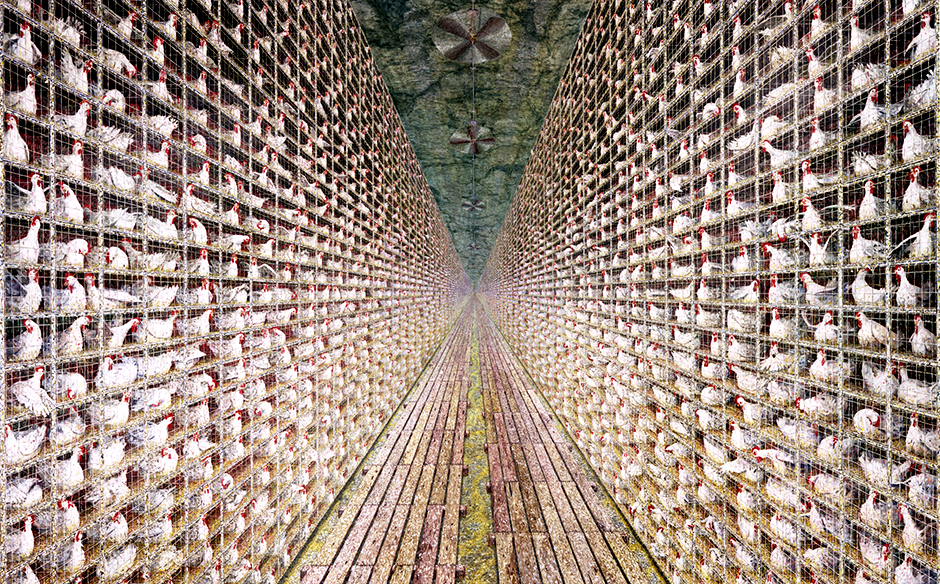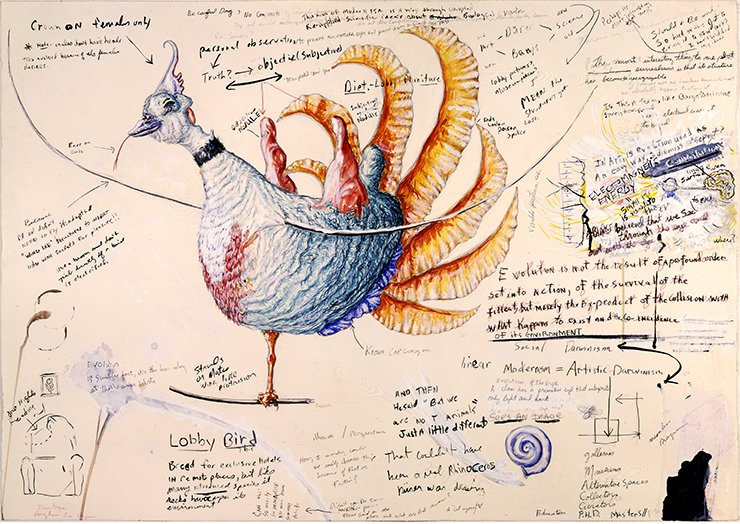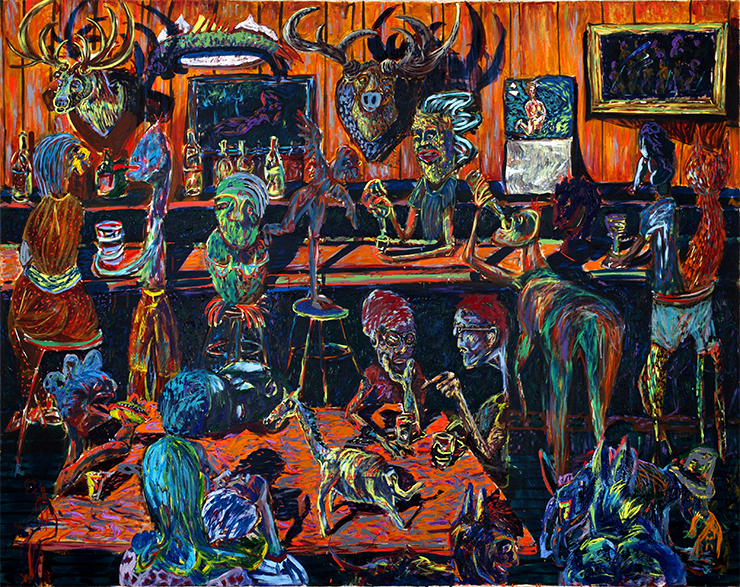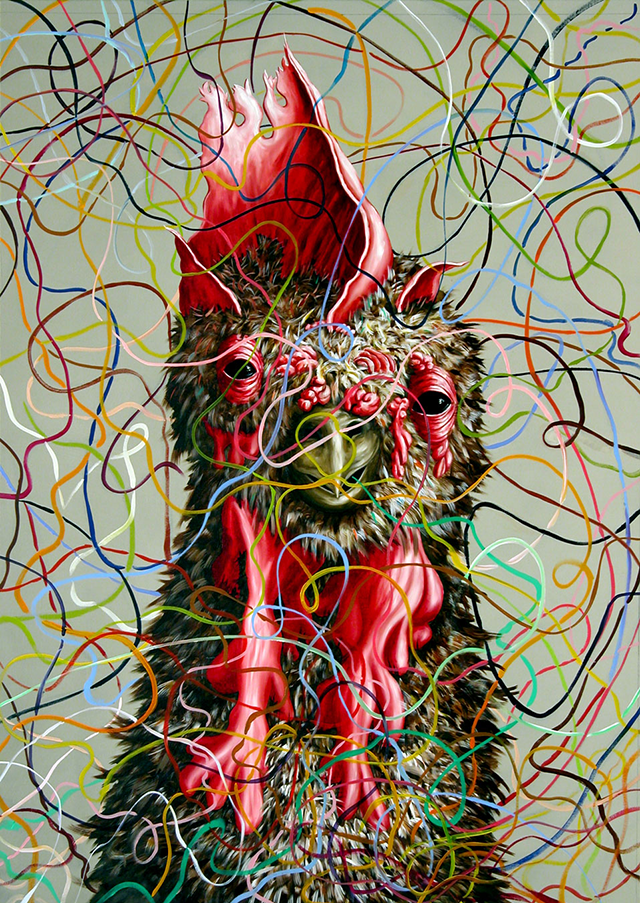
Doug Argue’s famous chickens paintings return to Weisman with new exhibit
Argue’s chicken portraits take the various individual chickens from the original painting and blow them up to huge portraits in and of themselves. They are majestic and painterly, adorned with gnarly, extraneous wattles that drip from the heads of the chickens.
By Sheila Regan |

Loan from Cafesjian Art Trust
In 1994, artist Doug Argue painted an epic, Upton Sinclair-esque painting of chickens in a farm factory. The chickens roost in small cages on each side, with the perspective constructed so that the angles go toward a vanishing point in the far distance.
Argue’s “untitled” chicken factory painting was a popular staple of the Weisman’s galleries for many years. It was on a long-term, approximately 18-year loan at the museum from the Cafesjian Art Trust, named after Armenian entrepreneur and philanthropist Gerard Cafesjian, who was based in Minnesota. CAT now has a museum in Shoreview, but back in 2012, the Trust made the decision to ship Argue’s chicken painting to The Cafesjian Center for the Arts located in Armenia.
In 2017, the piece briefly returned to the Weisman. Now it’s back, grounding an exhibition of Argue’s work, along with numerous other chicken portraits, paintings inspired by Picasso, the Gopher Bar in Saint Paul, and dotted with letters, fish, and the humanity of the infinite. The survey exhibition is titled “Doug Argue: Letters to the Future.”

Image courtesy of the artist
Elizabeth Armstrong curated Argue’s first museum show with Jim Lutes at the Walker Art Center back in 1985. She’d later become curator of contemporary art at the Minneapolis Institute of Art and now works as an independent curator. She’s returned to organize the most recent exhibition.
“I was just a young curator with the Walker,” Armstrong tells me at a preview event. “And I was like, I want to do something not Walker-ish.” Armstrong had recently finished graduate school at Berkeley where she had been studying German and Austrian expressionism. Shend had just seen a solo exhibition of Philip Guston, and saw similarities in Argue’s work.
“He was kind of a wild child,” Armstrong tells me. “I just walked into his studio and thought God, this guy can’t stop.”
Argue is a former student, though not a graduate of the University of Minnesota. After two years studying in Bemidji, Argue came to the University of Minnesota’s art department his third year, but he didn’t make it very long.
“I was a disruption,” he recalls at the preview event.
Having been used to the freedom to pursue his own projects, Argue remembers attending a still life class at the U, and banging on metal, while the other students all quietly worked on canvas.
“It’s like Monty Python,” Argue says. I’m kicking the metal, and I have cans of enamel paint, and I’m dumping it. The painting teachers didn’t know what to do with me, and they kept moving me out.” Eventually, he’d find a mentor in Wayne Potratz, a sculpture professor at the U, who invited Argue to work in the department’s foundry. “And Wayne was like, I love this. Just keep working.”

Collection of Weisman Art Museum
The popularity of Argue’s chicken painting has resulted in a phenomenon where visitors have grown attached to particular chickens in the painting, says Armstrong.
“He said people started seeing the giant painting and saying— oh, look at that chicken. I like that chicken. He thought, ‘this is absurd’, but then he said, ‘well, I’m going to make chicken portraits.’”
Argue’s chicken portraits take the various individual chickens from the original painting and blow them up to huge portraits in and of themselves. They are majestic and painterly, adorned with gnarly, extraneous wattles that drip from the heads of the chickens. “Lucy,” painted in 2002, looks like she’s been attacked by sticky red gel, and yet the portrait carries a weight of importance in the attention to detail. Another portrait, ‘Chicken Bits,” also painted in 2004, has erased the chicken altogether, and left only the bird’s slimy red bits.
Besides all things chicken, the Weisman exhibition features paintings Argue made as a young father. They are intimate, and rather unsettling. The father’s face doesn’t appear in the paintings, you just see his hands and sometimes his torso. The giant-ness of the father looms over the son, as if the parent remains largely unreachable. The child’s face, meanwhile, is world-weary and looks both innocent and traumatized.
In other works, Argue paints fantastical, sometimes gruesome scenes. One painting of the Gopher Bar in Saint Paul features not just the taxonomy in the bar, but also various regulars as animals themselves. Argue also liberally references famous works, like Pablo Picasso’s “Les Demoiselles d’Avignon,” which in Argue’s version is covered with a kind of translucent veil.

Loan from the Hargreaves collection
A real treat are the science fiction botanical paintings that offer a window into Argue’s darkly humorous imagination. They’re filled with mutations, cross-breeding monstrosities, and clever observations.
In more recent work, Argue has explored repetition and wonder. For Armstrong, the specificity of the repeating images in Argue’s work acts as a kind of antidote to the looming future of artificial intelligence.
“We’re in the shadow of AI,” Armstrong says. “Looking at Doug’s paintings, I feel like it’s holding on to the human world, holding on to a handmade, hand touched kind of expression. As brilliant as AI is, we don’t think it can translate the human soul.”
Doug Argue: Letters to the Future runs through September 10 at the Weisman Art Museum (free).